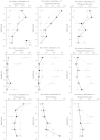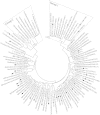Ecological restoration alters microbial communities in mine tailings profiles
- PMID: 27126064
- PMCID: PMC4850430
- DOI: 10.1038/srep25193
Ecological restoration alters microbial communities in mine tailings profiles
Abstract
Ecological restoration of mine tailings have impact on soil physiochemical properties and microbial communities. The surface soil has been a primary concern in the past decades, however it remains poorly understood about the adaptive response of microbial communities along the profile during ecological restoration of the tailings. In this study, microbial communities along a 60-cm profile were investigated in a mine tailing pond during ecological restoration of the bare waste tailings (BW) with two vegetated soils of Imperata cylindrica (IC) and Chrysopogon zizanioides (CZ) plants. Revegetation of both IC and CZ could retard soil degradation of mine tailing by stimulation of soil pH at 0-30 cm soils and altered the bacterial communities at 0-20 cm depths of the mine tailings. Significant differences existed in the relative abundance of the phyla Alphaproteobacteria, Deltaproteobacteria, Acidobacteria, Firmicutes and Nitrospira. Slight difference of bacterial communities were found at 30-60 cm depths of mine tailings. Abundance and activity analysis of nifH genes also explained the elevated soil nitrogen contents at the surface 0-20 cm of the vegetated soils. These results suggest that microbial succession occurred primarily at surface tailings and vegetation of pioneering plants might have promoted ecological restoration of mine tailings.
Figures





Similar articles
-
Soil-covered strategy for ecological restoration alters the bacterial community structure and predictive energy metabolic functions in mine tailings profiles.Appl Microbiol Biotechnol. 2017 Mar;101(6):2549-2561. doi: 10.1007/s00253-016-7969-7. Epub 2016 Nov 22. Appl Microbiol Biotechnol. 2017. PMID: 27878335
-
Restoration with pioneer plants changes soil properties and remodels the diversity and structure of bacterial communities in rhizosphere and bulk soil of copper mine tailings in Jiangxi Province, China.Environ Sci Pollut Res Int. 2018 Aug;25(22):22106-22119. doi: 10.1007/s11356-018-2244-3. Epub 2018 May 25. Environ Sci Pollut Res Int. 2018. PMID: 29802615
-
Soilless revegetation: An efficient means of improving physicochemical properties and reshaping microbial communities of high-salty gold mine tailings.Ecotoxicol Environ Saf. 2021 Jan 1;207:111246. doi: 10.1016/j.ecoenv.2020.111246. Epub 2020 Sep 11. Ecotoxicol Environ Saf. 2021. PMID: 32927157
-
Is rhizosphere remediation sufficient for sustainable revegetation of mine tailings?Ann Bot. 2012 Jul;110(2):223-38. doi: 10.1093/aob/mcs115. Epub 2012 May 30. Ann Bot. 2012. PMID: 22648878 Free PMC article. Review.
-
Revitalizing contaminated lands: A state-of-the-art review on the remediation of mine-tailings using phytoremediation and genomic approaches.Chemosphere. 2024 May;356:141889. doi: 10.1016/j.chemosphere.2024.141889. Epub 2024 Apr 5. Chemosphere. 2024. PMID: 38583533 Review.
Cited by
-
Revegetation by sowing reduces soil bacterial and fungal diversity.Ecol Evol. 2019 Dec 8;10(1):431-440. doi: 10.1002/ece3.5906. eCollection 2020 Jan. Ecol Evol. 2019. PMID: 31988735 Free PMC article.
-
Soil Microbial Responses to Varying Environmental Conditions in a Copper Belt Region of Africa: Phytoremediation Perspectives.Microorganisms. 2024 Dec 27;13(1):31. doi: 10.3390/microorganisms13010031. Microorganisms. 2024. PMID: 39858800 Free PMC article.
-
A metagenomic survey of soil microbial communities along a rehabilitation chronosequence after iron ore mining.Sci Data. 2019 Feb 12;6:190008. doi: 10.1038/sdata.2019.8. Sci Data. 2019. PMID: 30747914 Free PMC article.
-
Treatment impacts on temporal microbial community dynamics during phytostabilization of acid-generating mine tailings in semiarid regions.Sci Total Environ. 2018 Mar 15;618:357-368. doi: 10.1016/j.scitotenv.2017.11.010. Epub 2017 Nov 10. Sci Total Environ. 2018. PMID: 29132003 Free PMC article.
-
The bacterial community of Quesnel Lake sediments impacted by a catastrophic mine tailings spill differ in composition from those at undisturbed locations - two years post-spill.Sci Rep. 2019 Feb 25;9(1):2705. doi: 10.1038/s41598-019-38909-9. Sci Rep. 2019. PMID: 30804448 Free PMC article.
References
-
- Mariotte P. et al. Subordinate plant species impact on soil microbial communities and ecosystem functioning in grasslands: Findings from a removal experiment. Perspect. Plant Ecol. Evol. Syst. 15, 77–85 (2013).
-
- Chen Y. et al. Changes of bacterial community structure in copper mine tailings after colonization of reed (Phragmites communis). Pedosphere 18, 731–740 (2008).
-
- Šnajdr J. et al. Dominant trees affect microbial community composition and activity in post-mining afforested soils. Soil Biol. Biochem. 56, 105–115 (2013).
-
- Shen Z., Sun Q. & Liu M. Soil carbon and nitrogen dynamics induced by tissue-litter decomposition of copper mine tailings from the gramineae and cryptogram communities, China. Anal. Lett. 47, 885–899 (2014).
-
- Shen Z., Wang Y., Sun Q. & Wang W. Effect of vegetation succession on organic carbon, carbon of humus acids and dissolved organic carbon in soils of copper mine tailings sites. Pedosphere 24, 271–279 (2014).
Publication types
MeSH terms
Substances
LinkOut - more resources
Full Text Sources
Other Literature Sources
Miscellaneous

